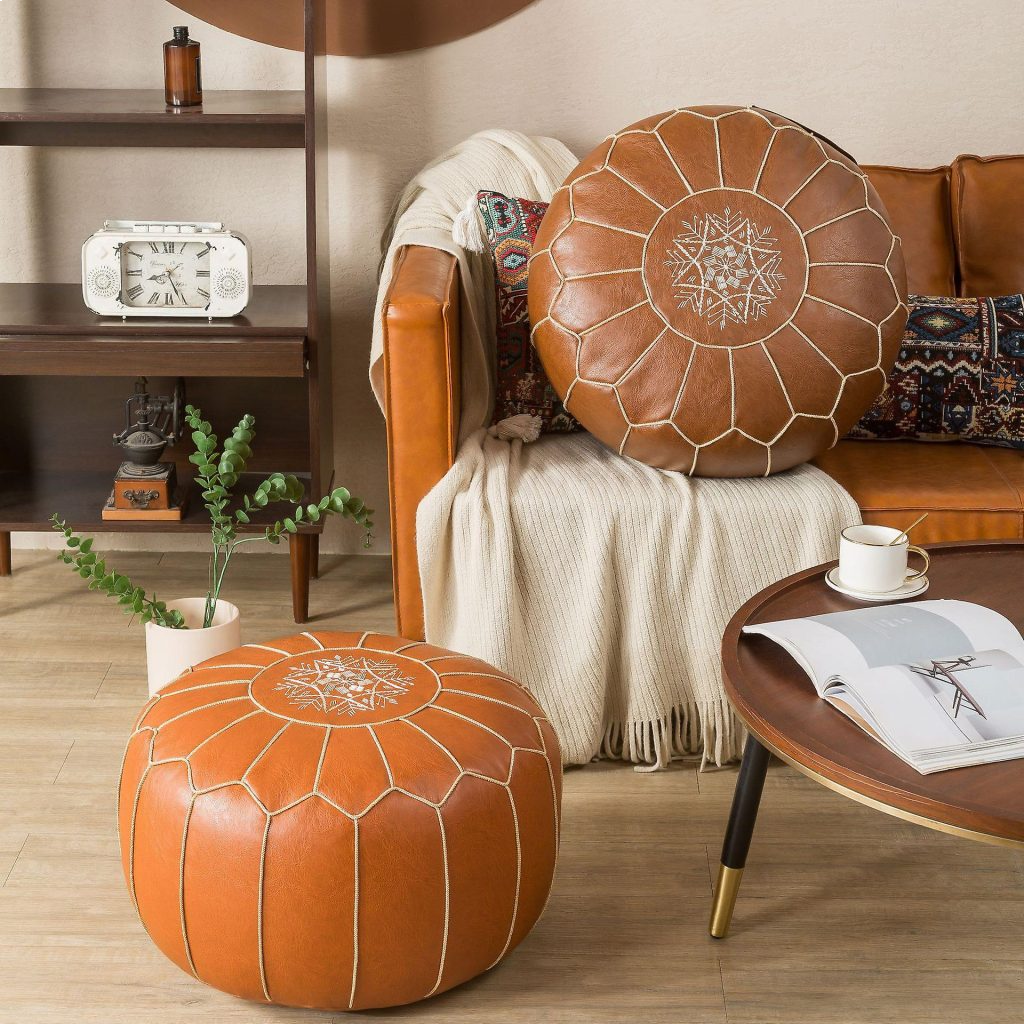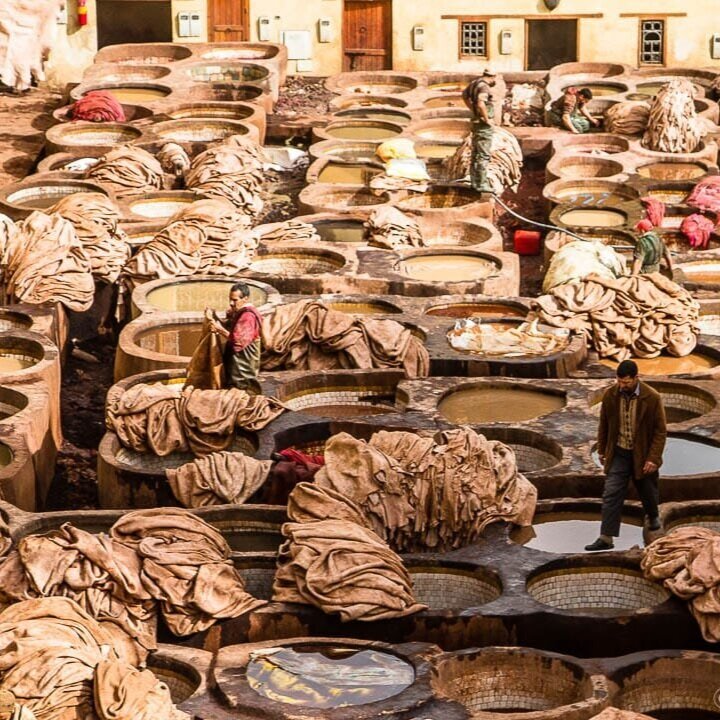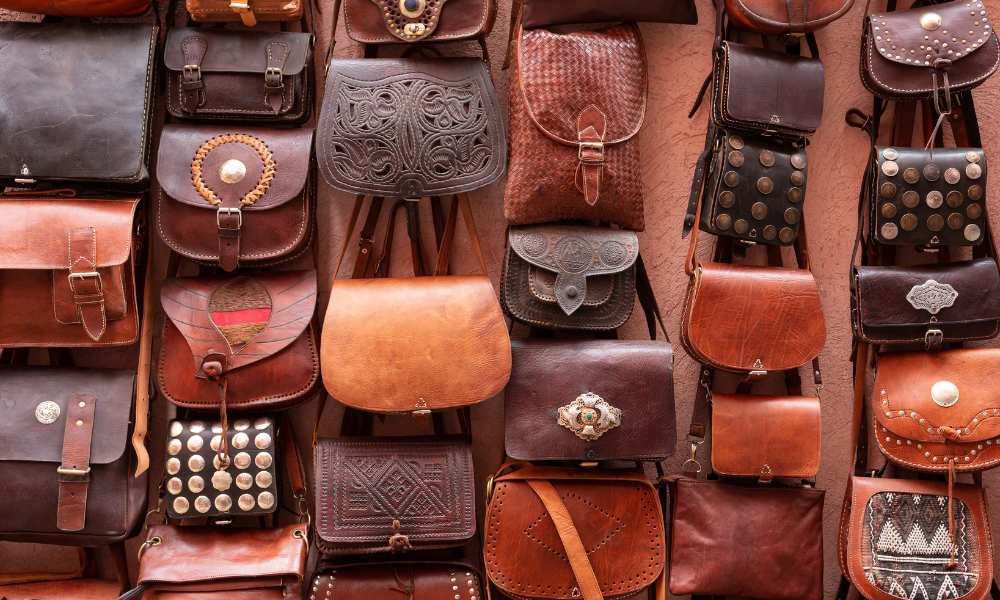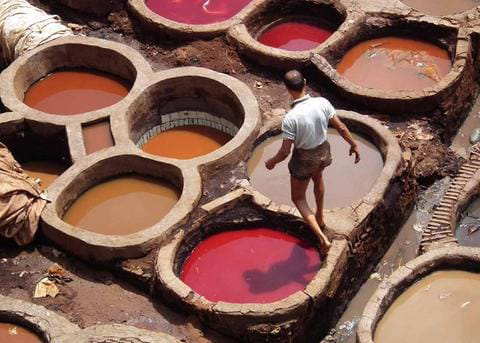Min Read

Moroccan leather has been long renowned worldwide for its quality and craftsmanship, with the North African country’s leather tanneries forming a compelling story of observance of ancient traditions, and awarding citizens and visitors alike, a captivating glimpse into centuries-old techniques. The history of leather tanneries in Morocco avails a window into the intricate processes involved in tanning leather, and the diverse range of leather products that tourists can expect to discover.
But within the explosion of scents and activity that these tanneries are known, one would be remiss to not acknowledge that the art of leather tanning in Morocco traces its roots back over a thousand years. The history of Moroccan leatherwork is closely connected to the Amazigh (Berber) tribes and the Arab influence on the region, the Amazigh people of whom are native to North Africa. They have practiced leather tanning for centuries as a means to create functional and decorative items, and with the contribution of the various facets of Arab expansion into the region in the 7th century, historians suggest that these traditional leatherworking techniques saw the infusion of new designs, dyes, and styles.
Today, Moroccan leather tanneries, especially those in cities like Fes, Marrakech, and Casablanca, have continued to employ age-old methods passed down through generations, highlighting how the leather tanning industry is deeply ingrained in the cultural fabric of these cities, creating both a unique historical heritage and a thriving trade.

So, what does the tanning process look like?
Make no mistake, the labour tanning process in is quite labour-intensive and requires a combination of artistry and skill, broadly divided into the following stages:
1. Soaking and Liming: This stage begins with raw hides, usually from sheep, goats, or cows. These raw hides are first soaked in water to remove dirt and soften the leather, before being soaked in a lime solution, which helps to loosen the fur from the hide.
2. Fur Removal and fleshing: After liming, tanners use a sharp knife to scrape away remnants of fur and any remaining flesh from the hide, with further cleaning to remove any excess fat or flesh.
3. The dyeing stage: The hides are soaked in natural dyes made from various sources, such as pomegranate, saffron, or indigo. This critical step is what gives Moroccan leather its distinctive colours and patterns. The tanneries of Fez in particular, are famous for their use of pigeon droppings, which contain ammonia that helps set the dyes. And so, if you have ever been, you’ll note the pungent sell at the tanneries. Well…there it is – pigeon droppings, cow urine and lime play their role here.
4. Drying: Once dyed, the hides are laid out to dry under the Moroccan sun. This natural drying process helps to set the colours and remove excess moisture.
5. Softening: The leather is softened yet again by treading on it, often a task for apprentices who dance on the hides to make them pliable.
6. Crafting and Design: The part consumers mostly look forward to – turning the leather into goods we’ll wear. After the leather is tanned and dyed, it is ready for the skilled artisans to transform it into various products. Moroccan craftsmen create a wide range of leather items, from shoes and bags to belts, jackets, and decorative items such as poufs and cushion covers.

What type of goods are made from Moroccan leather?
Moroccan leather tanneries have over decades, garnered global acclaim for producing a diverse array of products, each with its unique design and cultural significance. Some of the most popular leather items that tourists can discover in Morocco include leather bags, which come in various styles. From timeless leather satchels to intricately designed handbags and backpacks, craftsmanship and quality make them sought-after items.
Moroccan leather shoes are renowned for their comfort and durability, boasting styles that range from traditional Babouche slippers to more modern designs. The tanneries in Fes and Marrakech are particularly well-known for their footwear, and exquisite leather belts which also showcase intricate designs and metal embellishments are a common find. Combined, these two items can add a touch of Moroccan elegance to any outfit. Leather jackets also made in Morocco are not just functional but also stylish, coming in various designs, from classic to contemporary.
The home décor industry also benefits tremendously from Moroccan leather, with decorative items handcrafted with colourful, patterned leather turning into are a fantastic addition to any home decor. Other examples include Moroccan poufs, also crafted using leather with stunning embroidery and serving as extra seating, footrests, or decorative elements in homes. It is also commonplace to see the use of colourful leather incorporated in the design of such furnishings as lampshades, mirrors, and wall hangings.
Bolstering Morocco’s tourism economy
Visiting a Moroccan leather tannery is an experience that immerses tourists in both history and craftsmanship, such that some of the most renowned tanneries are open to the public and offer guided tours. Key tanneries for tourists to explore include Chouara Tannery in Fes, which is in fact is one of the oldest tanneries in the city, dating back over a thousand years. Tourists can witness the tanning process from a rooftop viewing platform. While it is an assault on the senses with the pungent smell of ammonia from pigeon droppings, cow urine and vibrant dyes, it remains a captivating experience if you can work your way through the strong smell.
Sidi Moussa Tannery in Marrakech offer guided tours, allowing visitors to observe the tanning process and the creation of leather products, which many cooperatives in Morocco have gone on to enhance the empowerment of local artisans, especially women. These cooperatives award tourists the opportunity to witness the production of high-quality leather products, provide insights into the traditional craft, its history and how leather tanning is an economic booster for artisans.

An ode to Morocco’s heritage and cultural preservation
The art of leather tanning in Morocco is a living testament to the rich cultural heritage and skilled craftsmanship of the country. Moroccan leather is renowned for its quality and diversity, making it a treasure trove for tourists seeking unique and authentic souvenirs. The tanneries, with their centuries-old techniques and commitment to preserving tradition, not only produce exquisite leather products but also offer visitors an immersive experience into the heart of Moroccan culture and history. A visit to a Moroccan leather tannery is not just a shopping excursion; it’s a journey into a world of heritage, artistry, and skill that continues to thrive in the bustling markets of this enchanting North African nation.